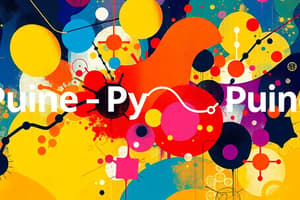Podcast
Questions and Answers
What role do nucleotides play in cellular processes?
What role do nucleotides play in cellular processes?
- They are the primary structural components of proteins.
- They are converted directly into glucose for energy.
- They are the only source of energy in the cell.
- They serve as the building blocks of nucleic acids. (correct)
Which purine bases are synthesized de novo?
Which purine bases are synthesized de novo?
- Adenine and Guanine (correct)
- Thymine and Cytosine
- Uracil and Thymine
- Cytosine and Uridine
What distinguishes thymine from uracil chemically?
What distinguishes thymine from uracil chemically?
- Thymine contains a carbonyl group only.
- Thymine contains a methyl group. (correct)
- Thymine is larger due to extra carbon atoms.
- Uracil contains a hydroxyl group.
What is formed when a pentose sugar is added to a purine base?
What is formed when a pentose sugar is added to a purine base?
How is a nucleotide formed from a nucleoside?
How is a nucleotide formed from a nucleoside?
Which of the following accurately describes the structure of a nucleotide?
Which of the following accurately describes the structure of a nucleotide?
What is a characteristic of the phosphate groups in nucleotides?
What is a characteristic of the phosphate groups in nucleotides?
Which nucleoside corresponds with deoxythymidine?
Which nucleoside corresponds with deoxythymidine?
Which of the following statements is true regarding pyrimidines?
Which of the following statements is true regarding pyrimidines?
What is the primary function of secondary messengers like cAMP and cGMP?
What is the primary function of secondary messengers like cAMP and cGMP?
What role does ribonucleotide reductase play in nucleotide metabolism?
What role does ribonucleotide reductase play in nucleotide metabolism?
Which compound is the final product of purine degradation?
Which compound is the final product of purine degradation?
What is the primary mechanism leading to the high uric acid levels in gout?
What is the primary mechanism leading to the high uric acid levels in gout?
Which enzyme is inhibited by the accumulation of dATP in the case of adenosine deaminase deficiency?
Which enzyme is inhibited by the accumulation of dATP in the case of adenosine deaminase deficiency?
What is one effect of the salvage pathway for purines?
What is one effect of the salvage pathway for purines?
What effect does binding of ATP have on ribonucleotide reductase activity?
What effect does binding of ATP have on ribonucleotide reductase activity?
Which condition is associated with an overproduction of uric acid due to genetic mutation?
Which condition is associated with an overproduction of uric acid due to genetic mutation?
What is the effect of the binding of dATP to the activity sites of ribonucleotide reductase?
What is the effect of the binding of dATP to the activity sites of ribonucleotide reductase?
What is a common treatment for an acute gout attack?
What is a common treatment for an acute gout attack?
During purine nucleotide degradation, which enzyme is responsible for converting xanthine to uric acid?
During purine nucleotide degradation, which enzyme is responsible for converting xanthine to uric acid?
What is the role of glutamine in purine nucleotide biosynthesis?
What is the role of glutamine in purine nucleotide biosynthesis?
Which step in purine biosynthesis is considered the committed step?
Which step in purine biosynthesis is considered the committed step?
What is the main function of ribonucleotide reductase (RR)?
What is the main function of ribonucleotide reductase (RR)?
What regulates the enzyme glutamine phosphoribosyl pyrophosphate amidotransferase (GPAT)?
What regulates the enzyme glutamine phosphoribosyl pyrophosphate amidotransferase (GPAT)?
Which enzyme is NOT involved in the salvage pathway of purine nucleotide synthesis?
Which enzyme is NOT involved in the salvage pathway of purine nucleotide synthesis?
What happens to PRPP levels in Lesch-Nyhan syndrome?
What happens to PRPP levels in Lesch-Nyhan syndrome?
Which method generates nucleoside diphosphates from nucleoside monophosphates?
Which method generates nucleoside diphosphates from nucleoside monophosphates?
What is a consequence of high levels of ribose-5-phosphate in purine synthesis?
What is a consequence of high levels of ribose-5-phosphate in purine synthesis?
What is the impact of sulfonamides on bacterial nucleotide synthesis?
What is the impact of sulfonamides on bacterial nucleotide synthesis?
In what tissues are enzymes for de novo purine synthesis often absent?
In what tissues are enzymes for de novo purine synthesis often absent?
Flashcards
What are nucleotides made of?
What are nucleotides made of?
Nucleotides are composed of a nitrogenous base, a pentose sugar (ribose or deoxyribose), and one, two, or three phosphate groups.
What are the three pathways for nucleotide synthesis?
What are the three pathways for nucleotide synthesis?
The three pathways are de novo synthesis, salvage pathways, and conversion of ribonucleotides to deoxyribonucleotides.
What is de novo synthesis?
What is de novo synthesis?
De novo synthesis is the biosynthesis of nucleotides from simple metabolic precursors like amino acids, ribose-5-phosphate, CO2, and one-carbon units.
What are salvage pathways?
What are salvage pathways?
Signup and view all the flashcards
What is the committed step in purine nucleotide biosynthesis?
What is the committed step in purine nucleotide biosynthesis?
Signup and view all the flashcards
What is the role of PRPP in purine synthesis?
What is the role of PRPP in purine synthesis?
Signup and view all the flashcards
What is the function of ribonucleotide reductase (RR)?
What is the function of ribonucleotide reductase (RR)?
Signup and view all the flashcards
What is the function of adenylate kinase?
What is the function of adenylate kinase?
Signup and view all the flashcards
What is Lesch-Nyhan syndrome?
What is Lesch-Nyhan syndrome?
Signup and view all the flashcards
How does methotrexate work as a chemotherapy drug?
How does methotrexate work as a chemotherapy drug?
Signup and view all the flashcards
What are Purines?
What are Purines?
Signup and view all the flashcards
What is the difference between ribonucleotides and deoxyribonucleotides?
What is the difference between ribonucleotides and deoxyribonucleotides?
Signup and view all the flashcards
What is the role of Ribonucleotide reductase?
What is the role of Ribonucleotide reductase?
Signup and view all the flashcards
How does dATP affect Ribonucleotide reductase?
How does dATP affect Ribonucleotide reductase?
Signup and view all the flashcards
What is the Purine Salvage Pathway?
What is the Purine Salvage Pathway?
Signup and view all the flashcards
How is Uric Acid produced?
How is Uric Acid produced?
Signup and view all the flashcards
What is Gout?
What is Gout?
Signup and view all the flashcards
What is the role of Adenosine Deaminase (ADA) in the immune system?
What is the role of Adenosine Deaminase (ADA) in the immune system?
Signup and view all the flashcards
What is the result of ADA deficiency?
What is the result of ADA deficiency?
Signup and view all the flashcards
How are hyperuricemia cases classified?
How are hyperuricemia cases classified?
Signup and view all the flashcards
What are nucleotides?
What are nucleotides?
Signup and view all the flashcards
Why are nucleotides non-essential nutrients?
Why are nucleotides non-essential nutrients?
Signup and view all the flashcards
What is the role of nucleotides in energy metabolism?
What is the role of nucleotides in energy metabolism?
Signup and view all the flashcards
What are the two main classes of nitrogenous bases in nucleotides?
What are the two main classes of nitrogenous bases in nucleotides?
Signup and view all the flashcards
What is the key difference between thymine and uracil?
What is the key difference between thymine and uracil?
Signup and view all the flashcards
What are unusual bases and where are they found?
What are unusual bases and where are they found?
Signup and view all the flashcards
What is a nucleoside?
What is a nucleoside?
Signup and view all the flashcards
What is a nucleotide?
What is a nucleotide?
Signup and view all the flashcards
What is the significance of the phosphate groups in nucleotides?
What is the significance of the phosphate groups in nucleotides?
Signup and view all the flashcards
What is the difference between a nucleoside monophosphate and a nucleoside triphosphate?
What is the difference between a nucleoside monophosphate and a nucleoside triphosphate?
Signup and view all the flashcards
Study Notes
Nucleotide Synthesis
- Nucleotides are the building blocks of DNA and RNA.
- They can be synthesized in the body, making them non-essential nutrients.
- Nucleotides are crucial for energy production (ATP), coenzyme function (NAD, NADP, FAD), and hormone signaling (cAMP, cGMP).
- They also act as regulatory molecules in various metabolic pathways.
- Nucleotides can be synthesized de novo or via salvage pathways.
- Purine bases include adenine and guanine.
- Pyrimidine bases include cytosine, uracil, and thymine (Thymine differs from uracil by a methyl group).
Purine Synthesis
- Purine synthesis occurs via a series of reactions that add carbon and nitrogen atoms to a ribose 5-phosphate precursor.
- The key enzyme in the first committed step of purine synthesis is glutamine phosphoribosylpyrophosphate amidotransferase (GPAT).
- This enzyme is highly regulated and is a rate-limiting step.
- Key precursors in purine biosynthesis include glycine, aspartate and glutamine, providing crucial carbon and nitrogen atoms.
- Synthesis of inosine monophosphate (IMP) is a crucial step.
- IMP is further converted into AMP and GMP by specific enzymatic reactions and pathways.
- Adenylosuccinate synthetase is an enzyme involved in AMP synthesis.
- IMP dehydrogenase converts IMP into xanthosine monophosphate (XMP)
Purine Salvage Pathway
- The salvage pathway recycles pre-formed purine bases and nucleosides.
- Two vital enzymes are hypoxanthine-guanine phosphoribosyltransferase (HGPRT) and adenine phosphoribosyltransferase (APRT).
- These enzymes utilize PRPP as ribose source.
- This pathway is crucial for efficiently reusing purine bases to produce nucleotides.
- HGPRT deficiency causes Lesch-Nyhan syndrome.
Lesch-Nyhan Syndrome
- Results from a deficiency in HGPRT.
- This deficiency impairs the salvage pathway for purines.
- Consequently, there's a buildup of uric acid due to increased de novo purine synthesis and decreased purine recycling.
- Characterized by self-mutilation and neurological problems.
Pyrimidine Synthesis
- Pyrimidine synthesis occurs through a different pathway than purine synthesis.
- The specific details of pyrimidine synthesis vary, but it involves the synthesis of orotic acid which is converted into various pyrimidine nucleotides.
Synthesis of Deoxyribonucleotides
- Deoxyribonucleotides (needed for DNA synthesis) are derived from ribonucleotides by the enzyme ribonucleotide reductase.
- Ribonucleotide reductase reduces ribonucleotides to their deoxy counterparts.
- The enzyme works on nucleoside diphosphates.
Regulation of Deoxyribonucleotide Synthesis
- Ribonucleotide reductase is regulated by allosteric sites.
- dATP inhibits enzyme activity.
- ATP activates enzyme activity.
- Substrate specificity sites influence the conversion of different ribonucleotides to deoxyribonucleotides.
Purine Degradation
- Dietary nucleic acids are initially broken down into mononucleotides.
- Mononucleotides are further hydrolyzed into nucleosides.
- Nucleosides are then degraded to produce free purine bases.
- Purine bases are further oxidized to uric acid.
Uric Acid and Diseases
- Uric acid is the final product of purine degradation.
- Elevated uric acid levels (hyperuricemia) can lead to gout (deposition of urate crystals in joints).
- Allopurinol inhibits xanthine oxidase, a key enzyme in uric acid production.
Adenosine Deaminase Deficiency (ADA)
- ADA deficiency primarily affects lymphocytes and inhibits DNA production.
- Deficiency leads to severe combined immunodeficiency (SCID).
- Treatment methods include bone marrow transplantation, replacement therapy, and gene therapy.
Salvage Pathways (General)
- Salvage pathways recover bases and nucleosides from broken-down DNA and RNA.
Studying That Suits You
Use AI to generate personalized quizzes and flashcards to suit your learning preferences.



